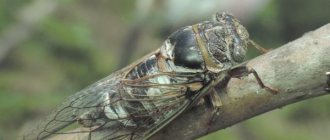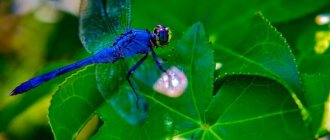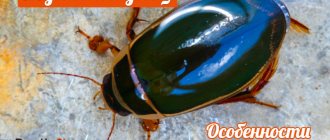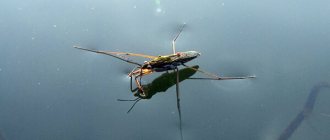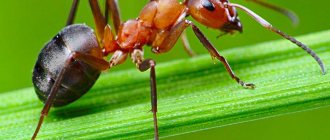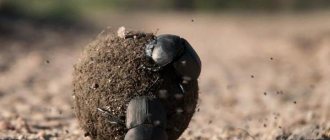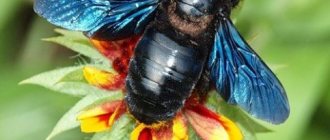The gadfly is a very large fly for the Central region of Russia. Today, science knows about 170 species of gadflies, some of which can cause serious harm to animals and people. The most dangerous types are:
- Skin gadfly (Dermatobia hominis)
- Horse botfly (gastric) (Gasterophilus intestinalis)
- Bovine gadfly (Hypoderma bovis)
- Cavity botfly (Oestrus ovis)
- Russian gadfly (Rhinoestrus purpureus)
Skin gadflies are the only members of the family that initially target humans, but this species does not live in Russia and is not even found in Eurasia. It is found only in Central and South America, Mexico, Brazil, Colombia, Peru, Argentina, Paraguay and Uruguay. Thus, you can only meet him if you travel to these countries.
The following 4 species are found almost all over the globe, including in Russia. All information given below will relate specifically to them.
Botflies prefer cattle and other mammals as food and a place for laying larvae, but this does not mean that humans are completely safe. The gadfly is not a blood-sucking insect, but can cause much more harm than damage to the skin.
Description of the insect
The gadfly is an insect from the order Diptera. The size of the insect is 15-20 mm, its body is covered with villi, and the color can vary from dark gray or brown to different shades of blue. The gadfly looks like a horsefly due to its large eyes. Adult gadflies do not feed; they lack mouthparts. Parasites are gadfly larvae that grow and develop in living flesh. They are dangerous for humans, as they can seriously harm them or even lead to death!
Spiders are the same as gadflies and horseflies
In relation to these small insects you can often hear the name "pout". Pautas are the name given to gadflies in the north. So both names of the fly carry the same meaning and meaning.
Lifestyle and habitat
Striped insects live on all continents except Antarctica. They prefer to live near human habitation and are found near ponds, pastures, and large farms. Species that are deadly to humans live in southern latitudes.
Types of gadflies
Insects are divided into several species according to different classifications. The first implies the difference between gadflies according to biological varieties.
Horse gadfly Gasterophilus intestinalis
The species lays eggs near the mouth, on the whiskers or on the legs of horses (less often cows), which is why it got its name.
Bovine gadfly Hypoderma bovis
The larvae of this species parasitize under the skin of cattle, such as bulls.
Human gadfly Dermatobia hominis
Like the bovine gadfly, the human one lays eggs subcutaneously. But now the larvae of the gadfly infect not cattle, but people.
Types of gadflies by organ of parasitism
This division according to the organ of parasitism is more common among gadflies, since several different biological species may have the same methods of laying eggs.
Cutaneous
The skin botfly lays eggs on top of the animal's skin. Most often, he chooses cattle as his prey. When the larva hatches, it burrows into the host's skin and parasitizes the tissue until it becomes a pupa. It is this type that is dangerous because it penetrates into the brain, into the gray matter and inside the skull. This is often fatal.
Cavitary
The most insidious type of gadfly. It is known to deposit larvae in the ears or nasal cavities. For example, the sheep botfly lays larvae in the noses of animals. When a sheep carries too many larvae, they penetrate into its brain and the animal becomes ill with “false whirligig,” in which it constantly spins around its axis, after which it dies from exhaustion. Yes, besides, this species does not have eggs in its development cycle; larvae appear immediately. There are also nasopharyngeal gadflies - a type of cavitary. They differ in that when the larvae are laid, they spray a little nutrient liquid into the animal’s nose, which irritates the mucous membrane. At this moment, feeling a burning sensation, the animal rears up, beats with its hooves and raises clouds of dust. This is how they sometimes save themselves from the larvae - when dust gets into their location, the larvae die.
Gastric
It exists in all regions except the north. The main goal of the larvae of this type of fly is to get the larvae from the oral cavity into the gastric cavity with nutrients. To do this, females attach larvae to grass, which animals eat, or to limbs, which animals often scratch with their teeth. Partial development of the larva occurs on the tongue. Parasites come out along with feces or through holes made in advance for breathing. This type includes horse gadflies.
Features and habitat
As a rule, flies of medium size are called gadflies; there are three families (which, in turn, have additional varieties, about 150 species) - gastric, subcutaneous, and cavitary.
In the photo there is a gadfly
The life of this insect is inextricably linked with the life of humans, since its larvae parasitize humans, or, most often, large mammals. Thus, the prevalence of gadflies is extremely wide (of course, a warm or temperate climate is preferable, as is the case for almost all insects).
Some species of gadfly in the photo are quite interesting, as they have huge colored (from bright green to poisonous yellow) “eyes”. However, in real life it is much more difficult to see this beauty due to the small size of the arthropod. The flight speed is low; as the gadfly approaches, a quiet high-pitched sound can be heard.
Needless to say, this beautiful fly can cause enormous harm to the health of humans and livestock. However, dealing with the gadfly is not so difficult - it is enough to timely and competently approach the disinsection of the main areas where livestock roam and where these arthropods gather, and they gather for mating mainly in the same places every year. Considering that the area is treated with hazardous chemicals, you should not do it yourself so as not to harm animals and people.
Nutrition
Adult gadflies cannot feed due to their physiological characteristics. They live off the reserves they accumulated as larvae.
The larvae can obtain nutrients while in the body of their host. The main nutrient for them is blood fluid. The gadfly larva can migrate in the body of its host, choosing the best places for comfortable living and feeding. Often this place is the gastrointestinal tract.
First aid for a gadfly bite
If all the symptoms of a gadfly bite are present, the recommended algorithm of action is as follows:
- Rinse the affected area thoroughly with water (or soap);
- to remove dirt, you need to drop a little hydrogen peroxide into the bite site or lubricate the area with brilliant green;
- if the bite caused severe pain, you can take a painkiller;
- in the absence of medicines, the use of natural “helpers” is allowed, for example, juice squeezed from a chamomile stem will effectively relieve pain and act as an antiseptic;
- if the bite site begins to swell, it is advisable to take antihistamines to prevent the spread of infection;
- the bite site should be monitored for at least a day;
- It wouldn’t hurt to go to the doctor, because gadflies often become carriers of dangerous infections, so it’s better to be on the safe side.
Lifespan
An adult lives very little - from 3 to 20 days. This is quite enough for gadflies to have offspring.
After the adult has lost most of its body weight, it dies. If a cold snap occurs during the life of the imago, then it almost does not fly, as a result of which it loses less nutrients and lives about a month longer.
The insect completes its full life cycle in 1 year.
Interesting Facts
- Botflies love to live in dense vegetation. It’s convenient for them to hide there. It is believed that if you mow the grass and thickets near your home, there will be much fewer dangerous insects in that area.
- A gadfly is not a horsefly. Yes, horseflies and gadflies are similar, but they do not belong to the same species. They are often confused, although gadflies are not blood-sucking insects, unlike horse flies, and do not have such large eyes.
- Oddly enough, gadflies are considered viviparous insects.
- These insects can parasitize almost any animal, even rodents or elephants and rhinoceroses. Almost every animal has its own type of gadfly, which affects exclusively representatives of this species of wildlife. For example, the squirrel gadfly or the elephant gadfly.
Means of protection against gadflies
As we have already said, adult individuals do not have mouthparts, do not feed, and do not sting. The supply of nutrients that they accumulated in themselves in the larval stage is enough for them. But when the larva pierces the skin, it can be called a bite. If you discover a gadfly bite, treatment should not be delayed. Of course, it is best to immediately consult a doctor, but if this is not possible, then you can try to remove the larva yourself. The first thing you need to do is take a thick, sticky or greasy product (tape, Vaseline, PVA glue) and apply it to the gadfly bite. In this case, oxygen will not enter the chamber and the larva will partially crawl out. Next, you need to carefully pull out the larva without crushing or tearing it. The bite of a gadfly precedes swelling, swelling and infection of the skin, so it is necessary to disinfect the wound. Below are photos showing a gadfly bite and the consequences it causes.
When it comes to animals, regular livestock inspections should be carried out. If larvae are detected, it is necessary, again, to lubricate the damaged area with Vaseline (or another product). Then you need to carefully remove the larva so that it does not rot and cause skin infection. At the end, be sure to treat the gadfly bite with an antibacterial agent.
Gadflies react to the smell of sweat and other strong odors, so it is necessary to follow hygiene rules, especially on hot summer days. You can protect yourself with sprays and creams against mosquitoes and other insects. There is also a folk remedy for horseflies and gadflies: a leather strap or lace soaked in Vishnevsky ointment. Gadflies are also repelled by the smell of birch tar, so this remedy can be used in the same way. It is believed that animals sense the approach of gadflies. They begin to behave strangely: shaking their heads, running, beating their tails. How they distinguish the gadfly from other flies is unknown. Unfortunately, human hearing and touch are not able to detect gadflies among many other flies, but now you know what this parasite looks like and how to protect yourself and your animals.
Natural enemies of the gadfly
Gadflies are lucky - they have practically no enemies in nature.
This is explained by the fact that gadflies rarely fly and live very little. When the insects have already found a suitable partner or “platform” for laying eggs, they return to their usual habitat – twilight and quiet places.
Adults are eaten by birds, whose main diet includes insects.
Ladybugs and praying mantises are also not averse to feasting on the gadfly. Due to their feeding predispositions, these insects were wanted to be used to reduce the population of gadflies.
Symptoms and consequences of a gadfly bite
When going out into nature on a hot summer day, you should remember that a dangerous gadfly may be waiting there. An insect bite on a person is not so subtle.
Usually, when “planning” to attack and approaching the intended victim, this fly buzzes very loudly and obnoxiously. So, in principle, there is a chance to brush it aside. But if the bite does occur, the following symptoms indicate it:
- a bright red spot on the skin with a diameter of one millimeter or slightly larger;
- severe burning, itching at the site of the bite and around it;
- bleeding that cannot be stopped for a long time;
- large swelling that forms some time after the bite (especially often on the face in the eye area);
- deterioration of health, symptoms of intoxication in the case of numerous bites (it happens that gadflies attack in a group).
Often, after a bite, a person develops an allergy or dermatitis. And even more often, the swelling grows to enormous sizes and does not go away for several days. To prevent this from happening, you need to take appropriate measures immediately after unsuccessful contact with an insect.
Life cycle of a gadfly
In short, the transformation cycle looks like this: eggs - larvae - pupae - adults.
Females can lay up to 3 clutches of 20 eggs at a time. 60 eggs is a very good result for a small insect!
The process of fertilization of all living things begins in May. In bad weather, females do not fly out, but hide.
Egg phase
One small female produces about half a thousand eggs. She does this as close as possible to the future host. She lays her eggs in the thick underfur of an animal or plant, which these animals eat.
One clutch contains about 20 eggs. Gadfly larvae form in 3-7 days. The timing of the formation of larvae from an egg is greatly influenced by weather conditions.
The female never lays all her eggs in one host; she distributes them among several victims.
Larval phase
Gadfly larva
The larva can be teardrop-shaped. It has the ability to make the layers of the epidermis softer, thanks to which the larva quickly enters the skin, creating itching and irritation of the victim’s skin.
After entering the skin tissue, the larvae move in different ways. Some strive to get into the gray matter of the brain, so they first need to travel through the arteries and nerves to the vertebrae and into the fatty tissue. Other gadfly larvae travel even worse - they live in the submucosal layer of the esophagus.
Over the entire journey, the size of the larva increases from 1.5 to 17 mm. As they develop, they need oxygen. Therefore, small holes are chewed out in the owner’s back – fistulas. Gradually, a capsule of connective tissue grows next to the fistula. There the insect lives until the pupal stage.
Pupal phase
Not all larvae turn into pupae. Their number is about 20 per 100 larvae.
Some die while traveling to other organs, some in the nodules. From the fistula the pupa falls to the ground. Most often this happens in the morning.
Pupation is completely completed within 1-7 days. The pupa always has an additional exoskeleton that protects it from damage.
The pupa develops for about a month, and at one point a fully developed imago emerges, ready to continue the genus.
Where and when should I expect to meet a gadfly?
The duration of the period of activity of gadflies depends on the climatic zone to which a particular area belongs. The longer the summer, the longer this period. In Russia it takes about three months – from June to August. When the botfly insect disappears, it’s time to prepare for the cold weather.
The gadfly is most active in dry, hot weather. In the open sun it turns into a real monster, but it does not like cloudy moisture.
The usual habitat of the gadfly is the banks of natural reservoirs, as well as forests and steppes. Often these insects choose certain areas where a large number of females accumulate. Naturally, males also fly here. Typically, such areas are areas where livestock are constantly walking or swampy areas. A person should stay away from them.
What is the danger to humans and animals?
Contrary to popular belief, the human gadfly from America does not bite humans directly. It uses an intermediate medium. For example, it often happens that a gadfly deposits larvae on a mosquito, which then transmits them to a person through a bite.
The lethal outcome for animals when larvae deposited by gadflies get into their tissues is very high. Intoxication and exhaustion occur when the parasite feeds on animal tissue. The larvae are especially dangerous if they enter the respiratory tract. Then pneumonia develops, which leads to death.
Is it possible to become infected with the botfly larva in Russia?
The only gadfly that parasitizes humans was found in America. There the first death was recorded - a 1.5-year-old child died due to the fact that a gadfly laid a large number of eggs under the skin, which caused intoxication of the body.
In most cases, children die due to internal brain injuries. In some cases, inflammation of the lymph nodes and headache occur.
But in Russia, although such cases are rare, they are still possible. Elderly people, those with mental development disorders, those with diabetes, those suffering from alcoholism, or those who have recently returned from tropical latitudes should be especially attentive.
It is also important to maintain hygiene throughout the body
Routes of infection
Larvae can, purely theoretically, be on any part of the body. But they are most beneficial on parts of the body with easy access or thin skin, such as the armpits, back or legs.
Sometimes the insect can deposit larvae in the eyes. Often females lay eggs on the head.
Signs of infestation with gadfly larva
The bite mark of a gadfly is very similar to that of a mosquito bite, so people often do not pay attention to it.
After some time, this area becomes inflamed, pus may come out, and swelling may develop. There is a noticeable movement under the skin. In addition to these signs, there are others that appear individually.
For example:
- nausea
- fatigue
- muscle pain
- heat
If a gadfly has deposited a larva in the eye, the developing insect will cause conjunctivitis, irritation of the mucous membrane, possible partial loss of vision, and fear of light.
If the larva is in the nose, it contributes to impaired sense of smell, headaches and swelling in the nasal cavity.
Symptoms and consequences of a gadfly bite
At the very beginning there are almost no symptoms. As can be seen from the description of the insect, the female gadfly is very small, and her legs are soft, so when in contact with the skin, a person will not feel anything, despite the fact that the female will lay a larva.
If you contact a doctor too late, a secondary infection develops. Sepsis often begins. An individual allergic reaction with varying degrees of severity is possible - from urticaria to anaphylactic shock.
Subcutaneous migration routes of the larvae
Just like in animals, the larva migrates in the human body. The path depends on the type of gadfly and how the person was infected with its larva. Rare but existing species, the females of which literally screw the larva under the skin, from where it can, moving through the blood, reach any organ it needs.
Consequences of gadfly larvae penetrating the skin of a person or animal
When the larva of the cutaneous or gastric botfly enters the body, so-called myiases develop. They can be genitourinary, intestinal or cutaneous.
These are dangerous parasitic diseases that are difficult to treat. One of the surest signs is exhaustion.
A rare syndrome is caused by the appearance and disappearance of bumps under the skin - hypodermatosis.
Of course, the consequences greatly depend on the specific organism, so at the slightest suspicion of infection with a gadfly larva, you need to consult a doctor . Only he can make the correct diagnosis.
Kinds
The family Nu-podermatidae includes insects in which the larva develops in the nodules under the skin of animals. They parasitize many mammals. Among them:
- Small rodents. Here development takes a little time. The female lays eggs on the fur. The larvae that emerge from them burrow under the skin. There is no migration.
- Large mammals. After laying on the hair, the larvae that emerge from the eggs begin migrating to the back of the animal. Their path of movement goes along the subcutaneous layer, inside the muscles and internal organs. Travel time is from 3 to 9 months.
There are types of gadflies:
- Gasterophilidae – parasites in the stomachs of animals. Flies of medium or large size (9-20 mm). Adults do not need food. They are found in the eastern hemisphere, but equines are common everywhere. The larvae live inside the stomachs of odd-toed ungulates, elephants, and hippopotamuses. The female gadfly lays about 2 thousand eggs on the skin or hair layer near the mouth. Gasterophilus pecorum lays eggs on the grass. The first instar larvae enter the digestive system and live until they grow. They come out naturally (with excrement). Animals infected with parasites develop gastrointestinal pathology.
- Horse (Gasterophilus intestinalis) is one of the common species. Length varies from 13 to 16 mm. The hairs on the body are yellow or brown. The wings are all with dark spots. A noticeable feature is a bright black dot in the radial vein. The insect uses horses and donkeys for its reproduction. In females, the ovipositor is strongly bent under the body. During flight, females lay on the surface of the skin in places where victims can scratch with their teeth. When the larva enters the mouth, it develops for about a month, then passes through the pharynx into the stomach. Their number sometimes reaches hundreds.
- Northern deer (Oedemagena taran-di) - lives off reindeer. Animals travel great distances to winter. There the insects grow, leave the host and move into the ground. With the onset of spring, deer migrate north. Young gadflies must fly many kilometers to again parasitize animals. Natural instinct drives the insects north, they reach the victims and begin to attack defenseless deer. One female can lay up to 650 eggs.
All gadflies are divided according to the type of mouth opening. In Oestridae typicae it is absent or underdeveloped. Representatives of the small Cuterebridae group have a more pronounced proboscis (mouth), without tentacles. Scientists divide the first type into three sections:
- Gastricolae - larvae with two hooks for penetration; there are special tubercles with small spines;
- Cavicolae – two hooks and large spines, the female is viviparous, no ovipositor;
- Cuticolae - there are no hooks, the spines are small, they are almost invisible.
Cattle attack Hypoderma bovis De G. bovine botfly . For horses and donkeys, the equine species has become a threat. Sheep try to escape from the sheep type Oestrus ovis L. Even wild animals have their own varieties:
- American squirrels are attacked by C. emasculator Fitch;
- Elephant intestines are infested with Cobboldia elephantis Brau;
- rhino suffers from Gastrophilus Rhinocerontis Ow.
In the tropics of Central America lives Ver macaque and moyocuil, which can accidentally attack a person. After a gadfly bites and the larva implants, a large tumor, or hardening, with a hole at the top grows. This type affects dogs and livestock.
The photo shows a gadfly larva
Treatment of parasitic infection caused by gadfly
Under no circumstances should you try to remove a larva that has penetrated the skin on your own!
This is fraught with dire consequences.
The fact is that gadfly larvae have hooks on the surface of the body, with which they cling to tissues in the host’s body. If even one or two hooks remain in the body, they will cause suppuration, which will then be difficult to identify and treat.
If the infection has not had time to develop, the gadfly larva is easily removed surgically under local anesthesia.
In the case when the parasite has already penetrated the organ of its localization, its removal requires not only a surgeon, but also other doctors - specialized specialists who deal with the organs into which the larva has penetrated.
After examination and determination of the severity of the infection, drug treatment is prescribed, for example, antibiotics and antiparasitic agents, or drug treatment followed by the possibility of surgical intervention.
How to protect yourself?
In order not to become a “house” for gadfly larvae, the following measures must be taken:
- Choose the right clothing to prevent insects from biting you and gaining access to your body.
- Maintain personal hygiene. Especially after forays into nature, hikes in the forest or visits to stud farms and farms. In such places, the risk of becoming a host to a parasitic fly larva is very high.
- Use mosquito nets on windows. Thus, you will not let in various blood-sucking insects that can carry the eggs of the gadfly.
- Treat clothes and body with special preparations. These can be repellents in the form of sprays or aerosols, creams or lotions.
- Use special traps against the gadfly in your summer cottage or farm. Although some people successfully practice traditional methods of protection (the smell of spruce needles, bird cherry, mint, cloves, etc. repels parasites).
- Carry out a daily preventive inspection of livestock and animals, combine it with cleaning the wool and treating it with special products that can repel gadflies (even ordinary Vishnevsky ointment or diesel fuel can help here).
Mating and flight
Mating occurs almost immediately after it emerges from the pupa. Scientists note that during this period, males live every year in the same place where they fly to mate. Next, fertilized females begin to actively search for future owners to breed offspring.
The laying method depends on the type of female insect:
- The line usually flies around a herd of animals, making characteristic sounds that frighten them. Having chosen a host, she lays one egg on each hair;
- The female esophagus has a different strategy: she sneaks up on the prey unnoticed, making short flights or crawling, then quickly lays 5-20 eggs per hair.
The number of eggs in the female’s abdomen can reach 700, each of which will subsequently hatch into a larva that will gnaw on its prey. Thanks to such high fertility, insects reproduce well even with a minimum number of adult individuals and their short lifespan. They have few enemies: among those who eat gadflies and other flies. and bugs - only birds.
The period of flight and mating of gadflies occurs depending on the climatic zone of habitat: in the southern regions it is longer, in the northern regions it is shorter.
Why is the gadfly insect dangerous?
The presence of parasites inside is always an unpleasant thing. The rapid activity of insect larvae in the body affects it much worse than any bite. In the early stages of its life, the insect gadfly does its best to poison its host with secreted toxins, and also significantly damages tissues, literally gnawing its way out through them. From prolonged proximity to parasites, the animal begins to suffer from hypodermatosis, its productivity is greatly reduced, and can reach complete exhaustion. Even fatalities have been recorded from the penetration of gadfly larvae into the brain.
Years
The timing of the start of flight and its duration depend entirely on the region of residence of the individuals. Longer flights in warm zones, shorter flights in northern latitudes.
The fight against gadflies can consist of preventive measures: good care, nutrition, timely cleaning of livestock skin from adhered pest eggs.
The lice eater is a microscopic mite that feeds on the hair and keratinized skin of animals. If you have strange growths on your lemon, then you know it’s a scale insect. Read here how to get rid of it.
Decontamination of premises will help get rid of such dangerous parasites as ticks. Read about safety measures when carrying out this procedure in the article at the link.
How to avoid meeting a gadfly and how to defeat it
Nothing is impossible in this world, and you can meet a gadfly even in the urban “jungle”. But the risk increases tenfold for those who travel into nature. Experienced travelers know how insidious the gadfly (insect) is. They also know how to fight it and protect themselves at least to a minimum. Here's what every tourist should take care of:
- about tents equipped with mosquito nets;
- about clothes of neutral colors - gadflies love bright colors;
- about wormwood, tansy, yarrow, which you can carry with you and lay around the tent;
- about chamomile, the branches of which can be thrown into a fire - such aromatic smoke will scare away gadflies.
And it is very important to remember: the gadfly is an insect (a photo of which can be seen in this article) is quite dangerous! Prevention measures should not be neglected. And if you happen to become a victim of an aggressor, then you should treat the bite very carefully. Who knows?! In this case, the old Russian proverb will come in handy: “God protects those who are careful.”
